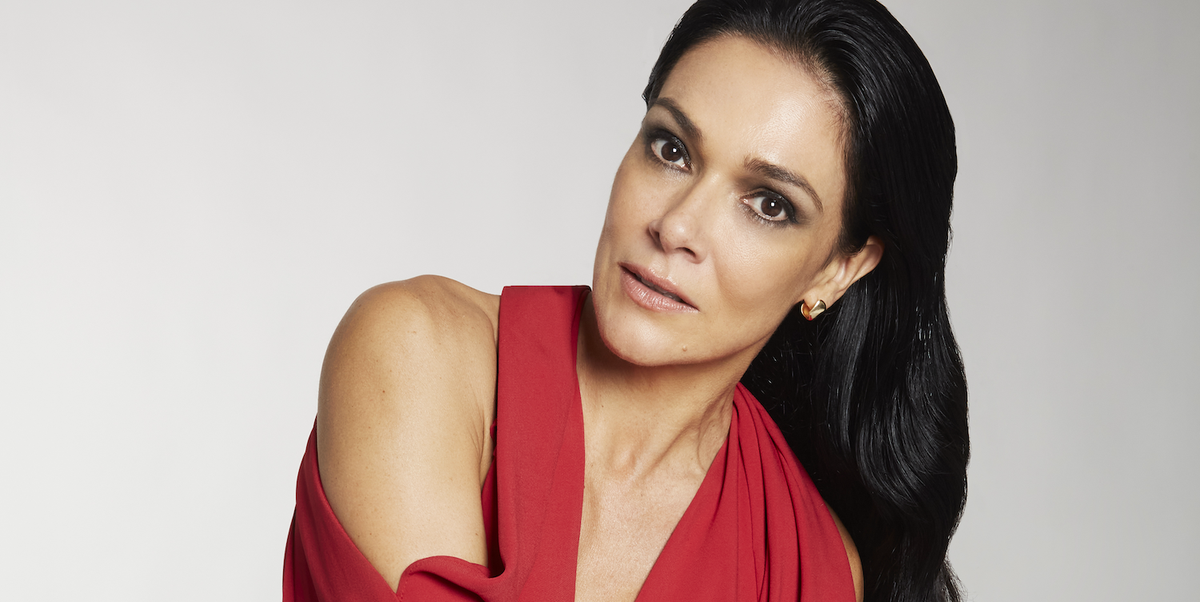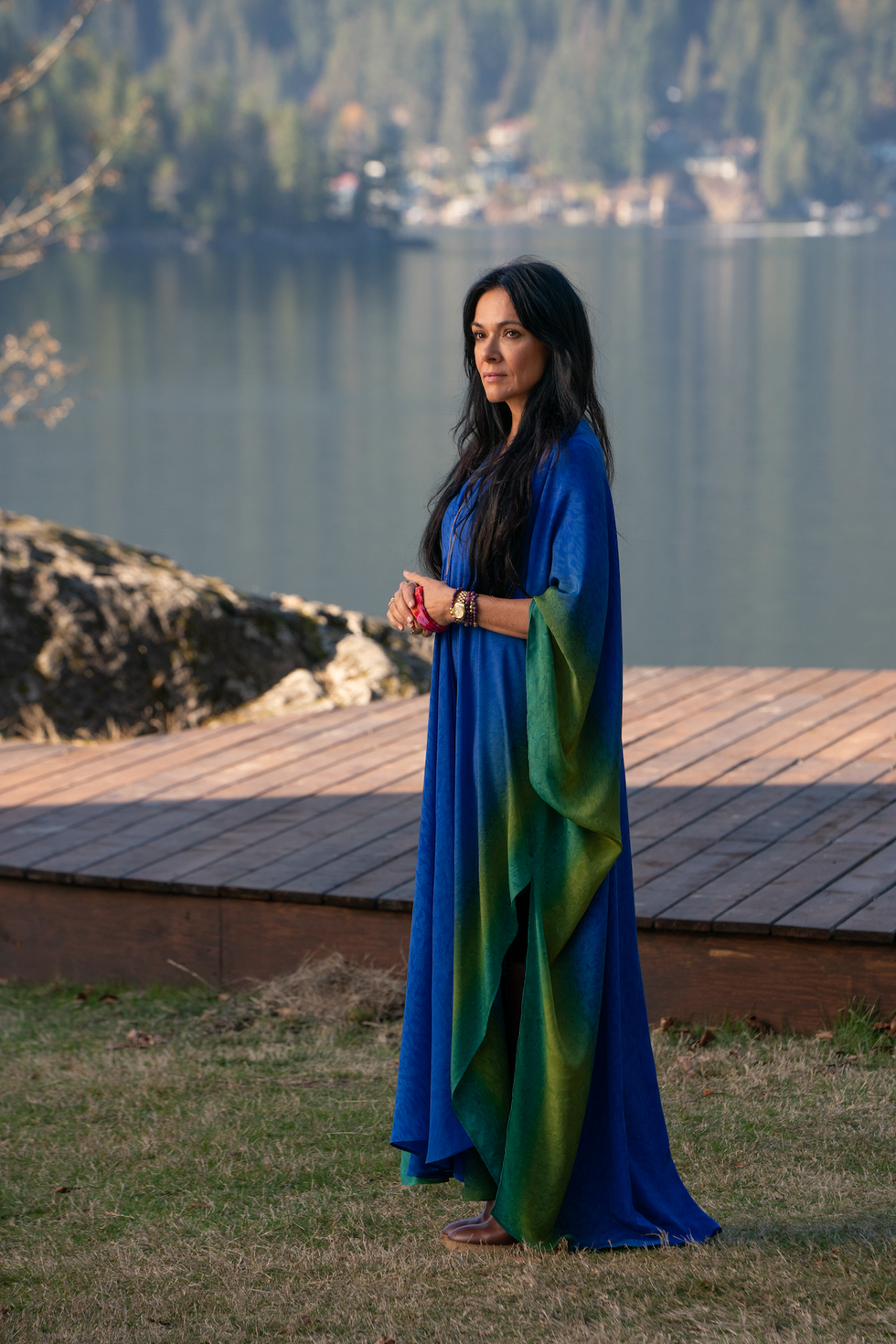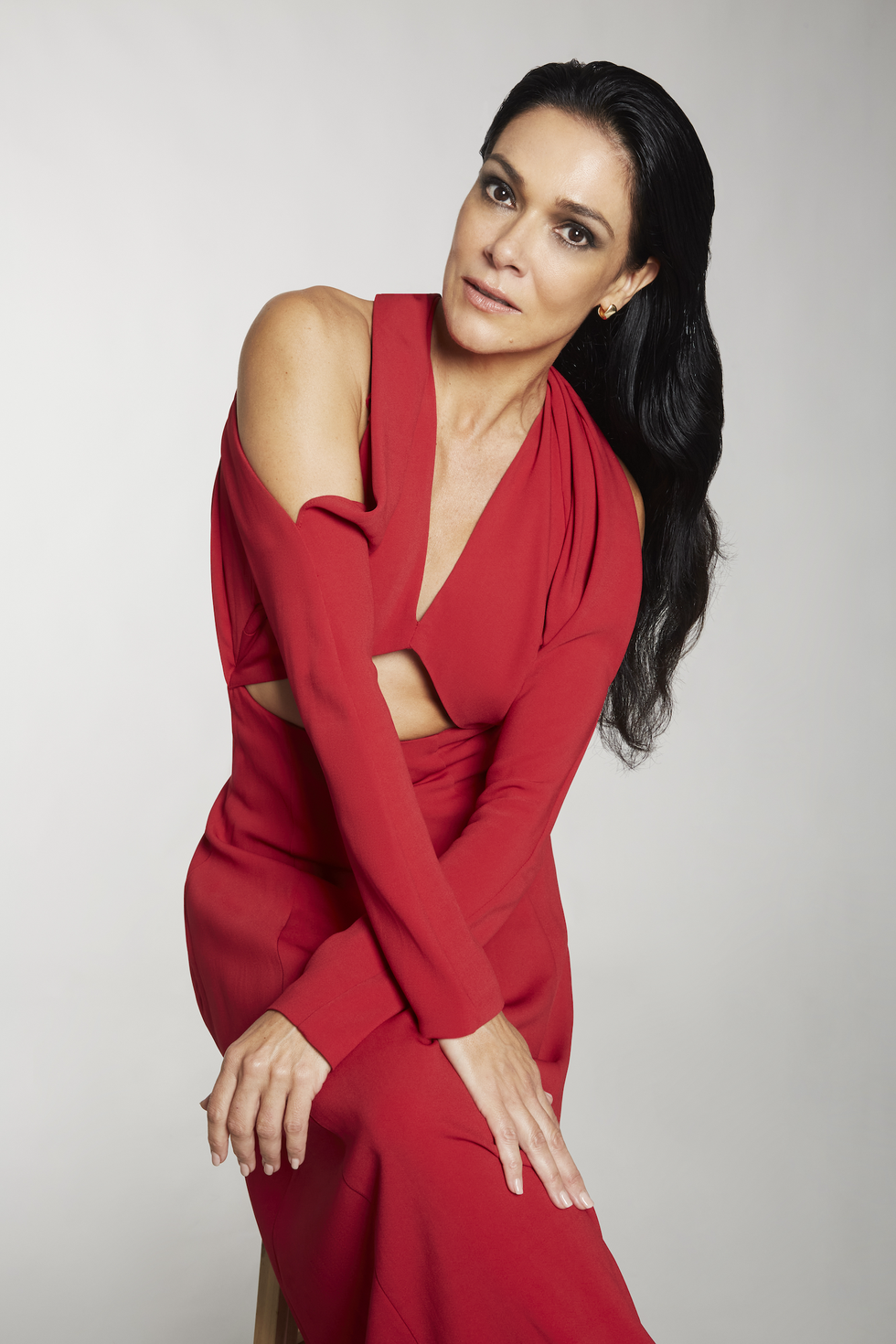Products You May Like
Lottie Matthews, the caftan-clad spiritual guru of Yellowjackets’ gory second season, considers herself a true believer. By proxy, then, so is her actress, the elegant if electric Simone Kessell, who stares at me over the rim of the mug gripped between her fingers and tries, repeatedly, to convince me Lottie’s not a liar. Or, anyway—she doesn’t want to be one.
“The present-day Lottie has reinvented herself, because the present-day Lottie doesn’t believe what happened in the past happened,” Kessell tells me, as our conversation winds between the technical and the existential, a well-worn path amongst the Yellowjackets cohort. “One of my first questions to the showrunners was, ‘Is she just doing this for financial gain or does she truly want to heal and help people?’ And the answer was like, ‘No, she truly believes in what she’s saying and what she’s serving.’”
In the universe of Yellowjackets’ present day, Lottie is now Charlotte Matthews, a survivor of the Flight 2525 crash that stranded her high school soccer team in the wilderness for 19 months. After enduring years of electroconvulsive therapy in Switzerland for her PTSD and accompanying hallucinatory “visions,” the middle-aged Lottie has launched her own wellness retreat (or “intentional community”) named Camp Green Pine, where she serves as benevolent overlord and healing instructor. As of the airing of episode 6 this week, Lottie had inadvertently lured a group of her surviving former teammates to converge upon Camp Green Pine, inciting what Kessell teases is “a turning point in the series.”
“The past is catching up,” Kessell says. “You can drape yourself in gorgeous orange caftans and flowy beautiful silk dresses and espadrilles and live, laugh, love, and—you know—namaste, and sage out the day. But at the end of it, the reality catches up.”
That’s a frightening concept for Lottie in particular, because she’s not altogether sure she can distinguish reality from fiction. For every moment she spends certain of her capacity to heal others, she spends another doubting that anything she experiences can be defined as “real.” Her “visions,” the ones that plagued her throughout those cold, awful months in the wilderness, have returned with a vengeance. In season 2, she sees terrible things: bloody bees; a Queen of Hearts card with the eyes scratched out; the ghost of her former teammate Laura Lee. In desperation, she offers her own blood as sacrifice to an unknown deity, praying that it “be enough.” However threatening, she’s convinced these sights cannot be real, that they must stem from the chemical imbalance of her own brain.
Kessell thinks Lottie’s dissonance is inherent to her character; it is as much a part of her as her signature jet-black hair. “I always see three Lotties in one,” she says. There’s the public-facing Lottie: the miracle worker. Then there’s “the businesswoman behind closed doors, who’s very, very premeditated and considered.” And finally, there’s the Lottie at the end of episode 6, “who is broken and traumatized. Her visions are really starting to kick in, and her post-traumatic stress disorder’s catching up with her, and she can’t keep it at bay.”
In an attempt to—fruitlessness be damned—try to keep it at bay, Lottie visits her psychotherapist in episode 6, armed with the knowledge that “it’s still happening.” Not only is Lottie enduring the visions, but a pervasive feeling has settled inside her body, a feeling that something (“it”) is leading her back to her teammates, and back to what they witnessed in the woods.
“Is it possible your fear of the past might be a fear of your illness?” the therapist asks.
The camera creeps ever closer to Kessell as the muscles of her face quiver with stress. “No,” Lottie says, shaking her head and leaning in. “No, that’s the problem. I’m not worried that I’m ill; I’m worried that I’ve never been ill.”
Her therapist probes further. “What is…it, Lottie?”
She begins to shake uncontrollably. “The power of that place. The god of that place,” she replies. “We did terrible things in its name. And I thought that, when we were rescued, that we left it there, but now I realize: We brought it back with us.”
This, then, is the ultimate fear: that the real delusion was not the delusions themselves but the treatment. That there is no treatment for the evil that followed Lottie home, because it is not an errant chemical but a spiritual presence. The only response she knows, then, is a sacrifice. “A bit like going to church,” Kessell says, then echoes, “‘Forgive me, father, for I have sinned.’”
Yet, even of this course of action Lottie can’t be certain. The fractured nature of her own life makes it impossible for her to trust her instincts. She’s now obsessed with the idea that the group must somehow atone for their crimes in the wilderness, except when it becomes less clear that what happened in the wilderness is as she remembers it. “Maybe it is just in her head, right?” Kessell says. “But that’s the duality that we don’t know. Maybe it is real.”
I ask Kessell what she thinks we, as audience members, are meant to interpret from these on-screen conversations about healing and trauma and repression. After some consideration, she throws the question back to me: What do I think is the takeaway? Stumbling over my words, I tell her I consider these scenes an acknowledgment: an understanding of the fear inherent in healing. Many of us living with mental illness or trauma come up against the concern that, should a specific method of healing fail (or reveal itself as inauthentic), we might be forced to look elsewhere for survival. And what if there is nowhere else? What do we do then?
Kessell agrees with this assessment. “That’s terrifying,” she says. “If you’re in treatment and you’ve been taking—maybe it’s medication, or you’re visualizing or doing affirmations and you’re staying in gratitude or whatever is your tonic, and then that tonic stops working, that’s terrifying.”
She continues, “Especially when you have to then show up and teach love and gratitude, but you’re not in it yourself. There’s this noise; you can’t turn it down. That little transistor radio in the back of your head, it’s scratchy. And I think, at some point, everybody in their life has that.”
Kessell is careful not to assign a specific mental illness to Lottie, or to align her with any specific inspiration in the world of woo-woo wellness. She says she pulled pieces of Lottie from church pastors, from priests, from her yoga-loving friends, and from the author and speaker Teal Swan. Above all, she wanted Lottie’s trauma to coexist with her radiance. She needed to be both empathetic and magnetic, the kind of leader you trust to take away your pain because they recognize it. “If someone can take our pain or make us understand it, then we will follow and give them whatever devotion,” Kessell says.
On the set of season 2, she even recognized some of this effect in her own life. The exhaustion of acting out Lottie’s fears every day had started breaking through Kessell’s ordinarily sunny demeanor. “It does wear off on you,” she admits. “You become porous, and it starts to seep in.” She became uncharacteristically concerned that, during the finale, she was “overacting,” and she implored director Karyn Kusama to tell her the truth. Was she overdoing it? Was she awful? She was, wasn’t she?
“Simone, you’re fantastic,” Kusama told her, and the fear evaporated.
“That was my little moment of, ‘Am I good enough?’” Kessell tells me. She pauses, almost as if catching herself. She sits back in her chair and shoots me a smile. “I haven’t told anyone that,” she says. “It’s fine because it’s the truth. The absolute truth.”
Culture Writer
Lauren Puckett-Pope is a staff culture writer at ELLE, where she primarily covers film, television and books. She was previously an associate editor at ELLE.


